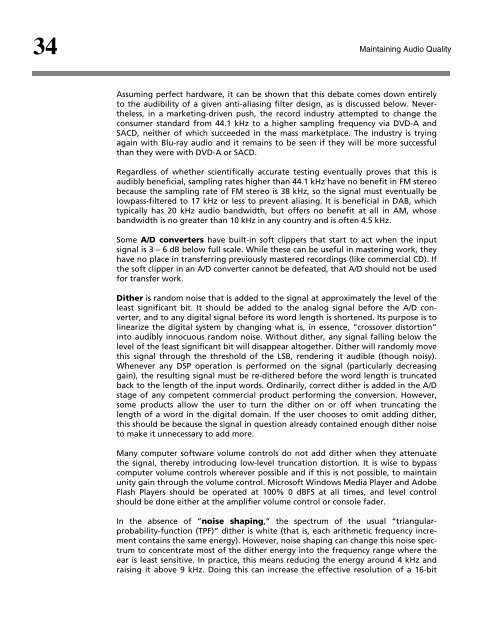Maintaining Audio Quality in the Broadcast Facility 2011 - Orban
Maintaining Audio Quality in the Broadcast Facility 2011 - Orban
Maintaining Audio Quality in the Broadcast Facility 2011 - Orban
Create successful ePaper yourself
Turn your PDF publications into a flip-book with our unique Google optimized e-Paper software.
34<br />
<strong>Ma<strong>in</strong>ta<strong>in</strong><strong>in</strong>g</strong> <strong>Audio</strong> <strong>Quality</strong><br />
Assum<strong>in</strong>g perfect hardware, it can be shown that this debate comes down entirely<br />
to <strong>the</strong> audibility of a given anti-alias<strong>in</strong>g filter design, as is discussed below. Never<strong>the</strong>less,<br />
<strong>in</strong> a market<strong>in</strong>g-driven push, <strong>the</strong> record <strong>in</strong>dustry attempted to change <strong>the</strong><br />
consumer standard from 44.1 kHz to a higher sampl<strong>in</strong>g frequency via DVD-A and<br />
SACD, nei<strong>the</strong>r of which succeeded <strong>in</strong> <strong>the</strong> mass marketplace. The <strong>in</strong>dustry is try<strong>in</strong>g<br />
aga<strong>in</strong> with Blu-ray audio and it rema<strong>in</strong>s to be seen if <strong>the</strong>y will be more successful<br />
than <strong>the</strong>y were with DVD-A or SACD.<br />
Regardless of whe<strong>the</strong>r scientifically accurate test<strong>in</strong>g eventually proves that this is<br />
audibly beneficial, sampl<strong>in</strong>g rates higher than 44.1 kHz have no benefit <strong>in</strong> FM stereo<br />
because <strong>the</strong> sampl<strong>in</strong>g rate of FM stereo is 38 kHz, so <strong>the</strong> signal must eventually be<br />
lowpass-filtered to 17 kHz or less to prevent alias<strong>in</strong>g. It is beneficial <strong>in</strong> DAB, which<br />
typically has 20 kHz audio bandwidth, but offers no benefit at all <strong>in</strong> AM, whose<br />
bandwidth is no greater than 10 kHz <strong>in</strong> any country and is often 4.5 kHz.<br />
Some A/D converters have built-<strong>in</strong> soft clippers that start to act when <strong>the</strong> <strong>in</strong>put<br />
signal is 3 – 6 dB below full scale. While <strong>the</strong>se can be useful <strong>in</strong> master<strong>in</strong>g work, <strong>the</strong>y<br />
have no place <strong>in</strong> transferr<strong>in</strong>g previously mastered record<strong>in</strong>gs (like commercial CD). If<br />
<strong>the</strong> soft clipper <strong>in</strong> an A/D converter cannot be defeated, that A/D should not be used<br />
for transfer work.<br />
Di<strong>the</strong>r is random noise that is added to <strong>the</strong> signal at approximately <strong>the</strong> level of <strong>the</strong><br />
least significant bit. It should be added to <strong>the</strong> analog signal before <strong>the</strong> A/D converter,<br />
and to any digital signal before its word length is shortened. Its purpose is to<br />
l<strong>in</strong>earize <strong>the</strong> digital system by chang<strong>in</strong>g what is, <strong>in</strong> essence, “crossover distortion”<br />
<strong>in</strong>to audibly <strong>in</strong>nocuous random noise. Without di<strong>the</strong>r, any signal fall<strong>in</strong>g below <strong>the</strong><br />
level of <strong>the</strong> least significant bit will disappear altoge<strong>the</strong>r. Di<strong>the</strong>r will randomly move<br />
this signal through <strong>the</strong> threshold of <strong>the</strong> LSB, render<strong>in</strong>g it audible (though noisy).<br />
Whenever any DSP operation is performed on <strong>the</strong> signal (particularly decreas<strong>in</strong>g<br />
ga<strong>in</strong>), <strong>the</strong> result<strong>in</strong>g signal must be re-di<strong>the</strong>red before <strong>the</strong> word length is truncated<br />
back to <strong>the</strong> length of <strong>the</strong> <strong>in</strong>put words. Ord<strong>in</strong>arily, correct di<strong>the</strong>r is added <strong>in</strong> <strong>the</strong> A/D<br />
stage of any competent commercial product perform<strong>in</strong>g <strong>the</strong> conversion. However,<br />
some products allow <strong>the</strong> user to turn <strong>the</strong> di<strong>the</strong>r on or off when truncat<strong>in</strong>g <strong>the</strong><br />
length of a word <strong>in</strong> <strong>the</strong> digital doma<strong>in</strong>. If <strong>the</strong> user chooses to omit add<strong>in</strong>g di<strong>the</strong>r,<br />
this should be because <strong>the</strong> signal <strong>in</strong> question already conta<strong>in</strong>ed enough di<strong>the</strong>r noise<br />
to make it unnecessary to add more.<br />
Many computer software volume controls do not add di<strong>the</strong>r when <strong>the</strong>y attenuate<br />
<strong>the</strong> signal, <strong>the</strong>reby <strong>in</strong>troduc<strong>in</strong>g low-level truncation distortion. It is wise to bypass<br />
computer volume controls wherever possible and if this is not possible, to ma<strong>in</strong>ta<strong>in</strong><br />
unity ga<strong>in</strong> through <strong>the</strong> volume control. Microsoft W<strong>in</strong>dows Media Player and Adobe<br />
Flash Players should be operated at 100% 0 dBFS at all times, and level control<br />
should be done ei<strong>the</strong>r at <strong>the</strong> amplifier volume control or console fader.<br />
In <strong>the</strong> absence of “noise shap<strong>in</strong>g,” <strong>the</strong> spectrum of <strong>the</strong> usual “triangularprobability-function<br />
(TPF)” di<strong>the</strong>r is white (that is, each arithmetic frequency <strong>in</strong>crement<br />
conta<strong>in</strong>s <strong>the</strong> same energy). However, noise shap<strong>in</strong>g can change this noise spectrum<br />
to concentrate most of <strong>the</strong> di<strong>the</strong>r energy <strong>in</strong>to <strong>the</strong> frequency range where <strong>the</strong><br />
ear is least sensitive. In practice, this means reduc<strong>in</strong>g <strong>the</strong> energy around 4 kHz and<br />
rais<strong>in</strong>g it above 9 kHz. Do<strong>in</strong>g this can <strong>in</strong>crease <strong>the</strong> effective resolution of a 16-bit



![[PDF] Using the ITU BS.1770-2 and CBS Loudness Meters ... - Orban](https://img.yumpu.com/50629372/1/190x245/pdf-using-the-itu-bs1770-2-and-cbs-loudness-meters-orban.jpg?quality=85)






![[PDF] Optimod-FM Feature Comparison - Orban](https://img.yumpu.com/41741615/1/190x245/pdf-optimod-fm-feature-comparison-orban.jpg?quality=85)






